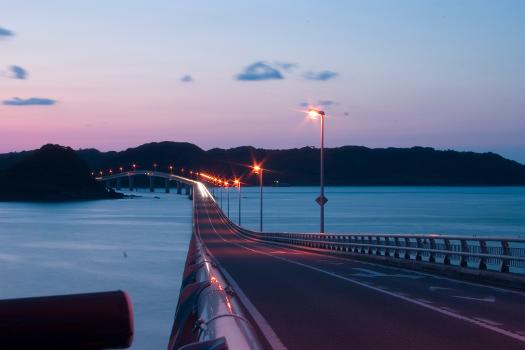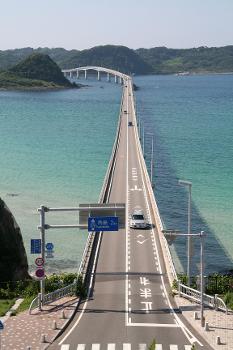General Information
| Name in local language: | 角島大橋 (Tsunoshima-Ōhashi) |
|---|---|
| Beginning of works: | September 1993 |
| Completion: | 3 November 2000 |
| Status: | in use |
Project Type
| Structure: |
Haunched girder bridge |
|---|---|
| Support conditions: |
for registered users |
| Function / usage: |
Road bridge |
| Material: |
Prestressed concrete bridge Structurae Plus/Pro - Subscribe Now! |
Location
| Location: |
Shimonoseki, Yamaguchi, Japan |
|---|---|
| Coordinates: | 34° 20' 51.74" N 130° 53' 43.11" E |
| Coordinates: | 34° 21' 19.25" N 130° 52' 42.42" E |
Technical Information
Dimensions
| total length | 1 780 m |
Materials
| piers |
reinforced concrete
|
|---|---|
| abutments |
reinforced concrete
|
Excerpt from Wikipedia
Tsunoshima Bridge (Japanese: 角島大橋, Hepburn: Tsunoshima-Ōhashi) is a bridge located in Yamaguchi Prefecture, Japan. The 1,780 m (5,840 ft) bridge, which connects the island of Tsunoshima to mainland Japan, is the second-longest bridge in the country.
Overview
Tsunoshima Bridge crosses the Amagaseto Strait in the Sea of Japan, linking the island of Tsunoshima with the mainland at Hōhoku, Shimonoseki. It is 1,780 m (5,840 ft) long, making it the second-longest bridge in Japan behind the Akashi Kaikyō Bridge.
The bridge is noted for ist distinctive curved shape: it proceeds straight as it extends from the mainland before curving as it passes Hatoshima, an uninhabited island located in the strait. As Tsunoshima Bridge is located within the borders of Kita-Nagato Kaigan Quasi-National Park, the bridge was intentionally curved to avoid passing through Hatoshima, thus preserving ist natural environment; the height of the bridge was also limited to preserve the landscape of the surrounding area.
History
Prior to the construction of Tsunoshima Bridge, Tsunoshima and the mainland were connected by a ferry that made seven daily round-trips. The ferry was frequently delayed and cancelled due to inclement weather, particularly in the winter; in 1983, a group of roughly 100 island residents formed a group to advocate for the construction of a bridge. Construction on Tsunoshima Bridge began in September 1993, with a total project cost of JP¥14.9 billion. The bridge opened on November 3, 2000. In 2003, the bridge was recognized with the Excellence Award by the Japan Society of Civil Engineers for ist environmentally-conscious design.
Tourism
While the transportation access provided by Tsunoshima Bridge has contributed significantly to Tsunoshima's tourism industry, the bridge is itself a popular tourist destination for ist panoramic views of the island and ist proximity to several sub-tropical beaches. Several viewing platforms and other amenities are located at Amagase Park, a park that is split into two sections on both ends of the bridge. Automobile commercials and television dramas are frequently filmed on and around the bridge.
Text imported from Wikipedia article "Tsunoshima Bridge"
and modified on 27 September 2021 according to the CC-BY-SA 3.0 license.
Participants
Currently there is no information available about persons or companies having participated in this project.
Relevant Web Sites
- About this
data sheet - Structure-ID
20081658 - Published on:
11/09/2021 - Last updated on:
26/12/2021



.jpeg)

.jpg)



